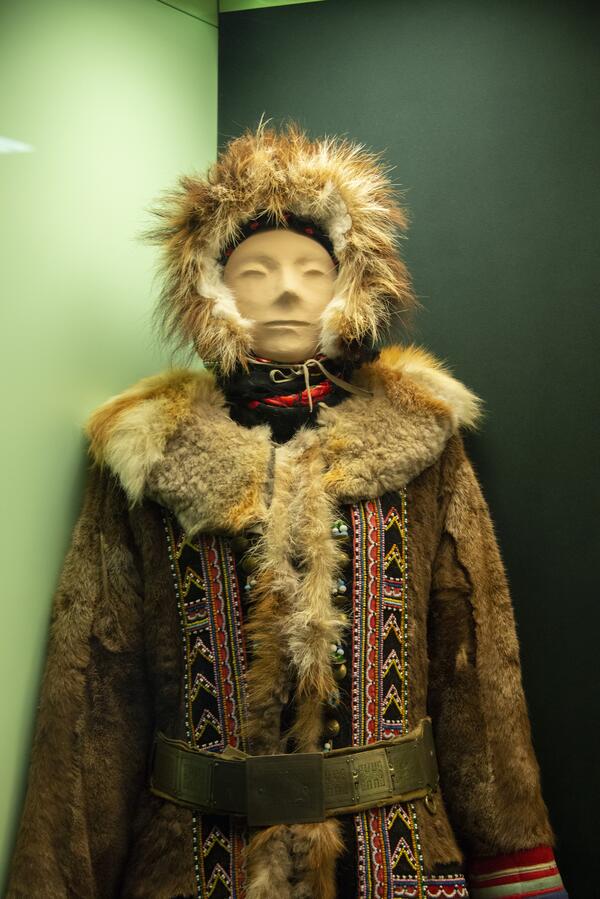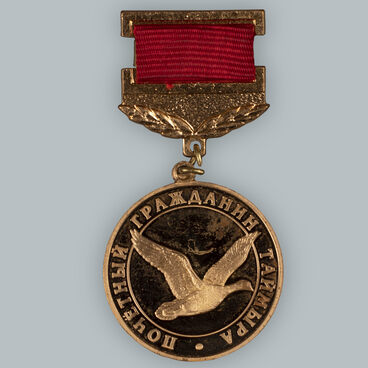The Dolgans are the largest indigenous group in the Taimyr municipal district.
Boris Osipovich Dolgikh, one of the leading experts on the history and ethnography of the peoples of Siberia, studied their origins.
In his research he came to a conclusion that this nationality began to form in the 18th — second half of the 19th century, thus becoming the youngest nationality of Taimyr. The Dolgans got their name from the Evenki clan “Dolgan”, but, besides Evenks, there are Yakuts and Russian “tundra” peasants in their ethnogenesis.
The Dolgans were the first of Taimyr peoples to master sewing of clothes from fabric: men wore shirts and trousers of Russian cut, women — skirts, jackets, and dresses with the closed apron put on over the basic clothes. The original Dolgan outfits were made in a single layer, with the hem elongated at the back. When starting to sew, the needlewomen first chose skins with the same short pile. Then they adjusted the measurements based on the length of their fingers, without using sewing patterns. Outer garments were skillfully decorated with beads and colored threads, fur mosaic, and inlay. Men’s and women’s hats and shoes were decorated with beads, while metal decorations were popular among women.
The Dolgan women’s outerwear consisted of a parka and a fur coat — lining of polar fox or hare fur.
This women’s “ardaydak hangyak” parka is made of dark-colored reindeer skins (nebluj) with the fur facing outwards. The back is cut off at the waist, with sides trimmed as semicircular wedges running from the shoulders to the waist; from the bottom edge of the wedges, the hem of the parka is gathered up. The narrow sleeves of straight cut end with cuffs made of strips of red and yellow chintz. Kamus mittens, made of wool from deer legs, are sewn directly to them.
The collar, edge of the flaps and hem are trimmed with fox fur. The flaps and hem are trimmed with wide black cloth edging embroidered with colored beads: crossed stripes, chevrons and broken-line ornaments. A wide stripe, embroidered with colored beads, runs along the flaps and the whole body, in the front the stripe is a little bit narrower. The decor of the garment is completed by copper tube pendants and large beads sewn on the back.
Boris Osipovich Dolgikh, one of the leading experts on the history and ethnography of the peoples of Siberia, studied their origins.
In his research he came to a conclusion that this nationality began to form in the 18th — second half of the 19th century, thus becoming the youngest nationality of Taimyr. The Dolgans got their name from the Evenki clan “Dolgan”, but, besides Evenks, there are Yakuts and Russian “tundra” peasants in their ethnogenesis.
The Dolgans were the first of Taimyr peoples to master sewing of clothes from fabric: men wore shirts and trousers of Russian cut, women — skirts, jackets, and dresses with the closed apron put on over the basic clothes. The original Dolgan outfits were made in a single layer, with the hem elongated at the back. When starting to sew, the needlewomen first chose skins with the same short pile. Then they adjusted the measurements based on the length of their fingers, without using sewing patterns. Outer garments were skillfully decorated with beads and colored threads, fur mosaic, and inlay. Men’s and women’s hats and shoes were decorated with beads, while metal decorations were popular among women.
The Dolgan women’s outerwear consisted of a parka and a fur coat — lining of polar fox or hare fur.
This women’s “ardaydak hangyak” parka is made of dark-colored reindeer skins (nebluj) with the fur facing outwards. The back is cut off at the waist, with sides trimmed as semicircular wedges running from the shoulders to the waist; from the bottom edge of the wedges, the hem of the parka is gathered up. The narrow sleeves of straight cut end with cuffs made of strips of red and yellow chintz. Kamus mittens, made of wool from deer legs, are sewn directly to them.
The collar, edge of the flaps and hem are trimmed with fox fur. The flaps and hem are trimmed with wide black cloth edging embroidered with colored beads: crossed stripes, chevrons and broken-line ornaments. A wide stripe, embroidered with colored beads, runs along the flaps and the whole body, in the front the stripe is a little bit narrower. The decor of the garment is completed by copper tube pendants and large beads sewn on the back.



